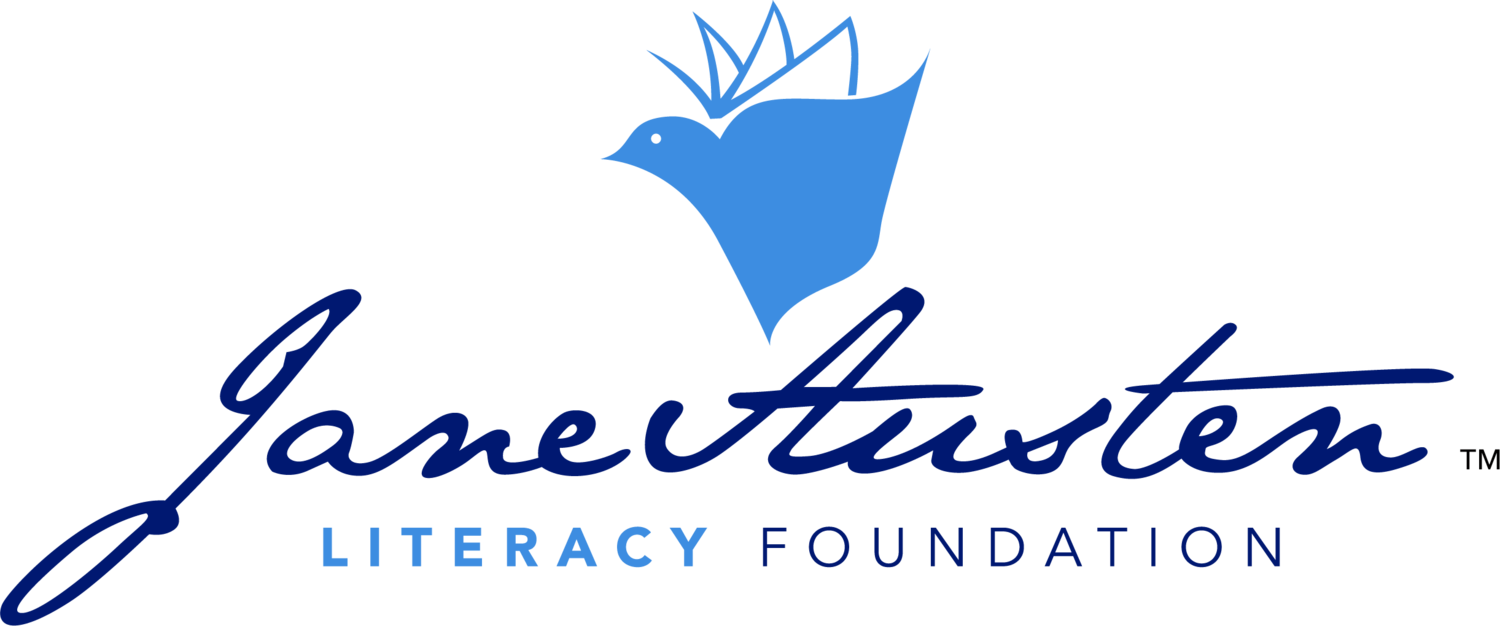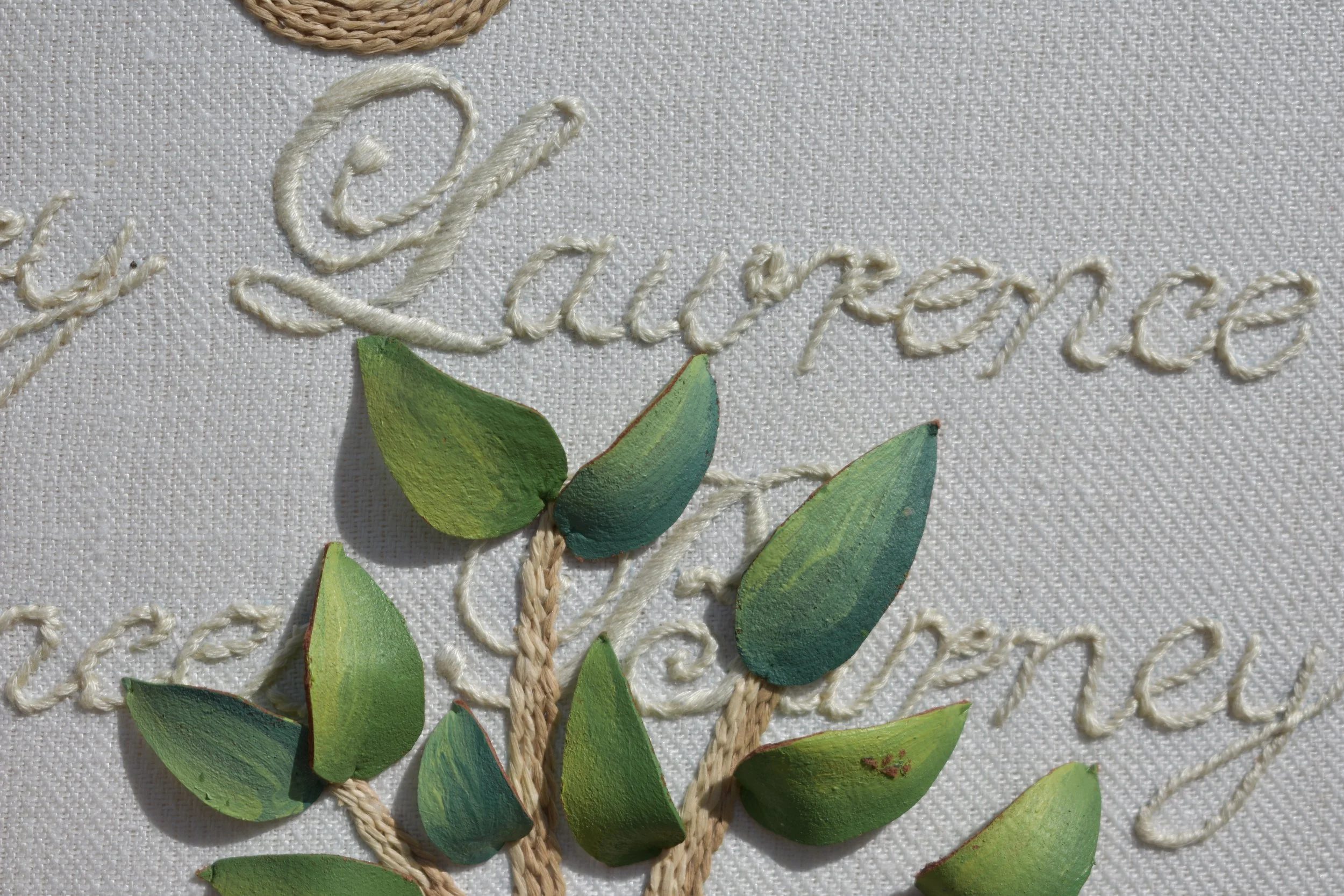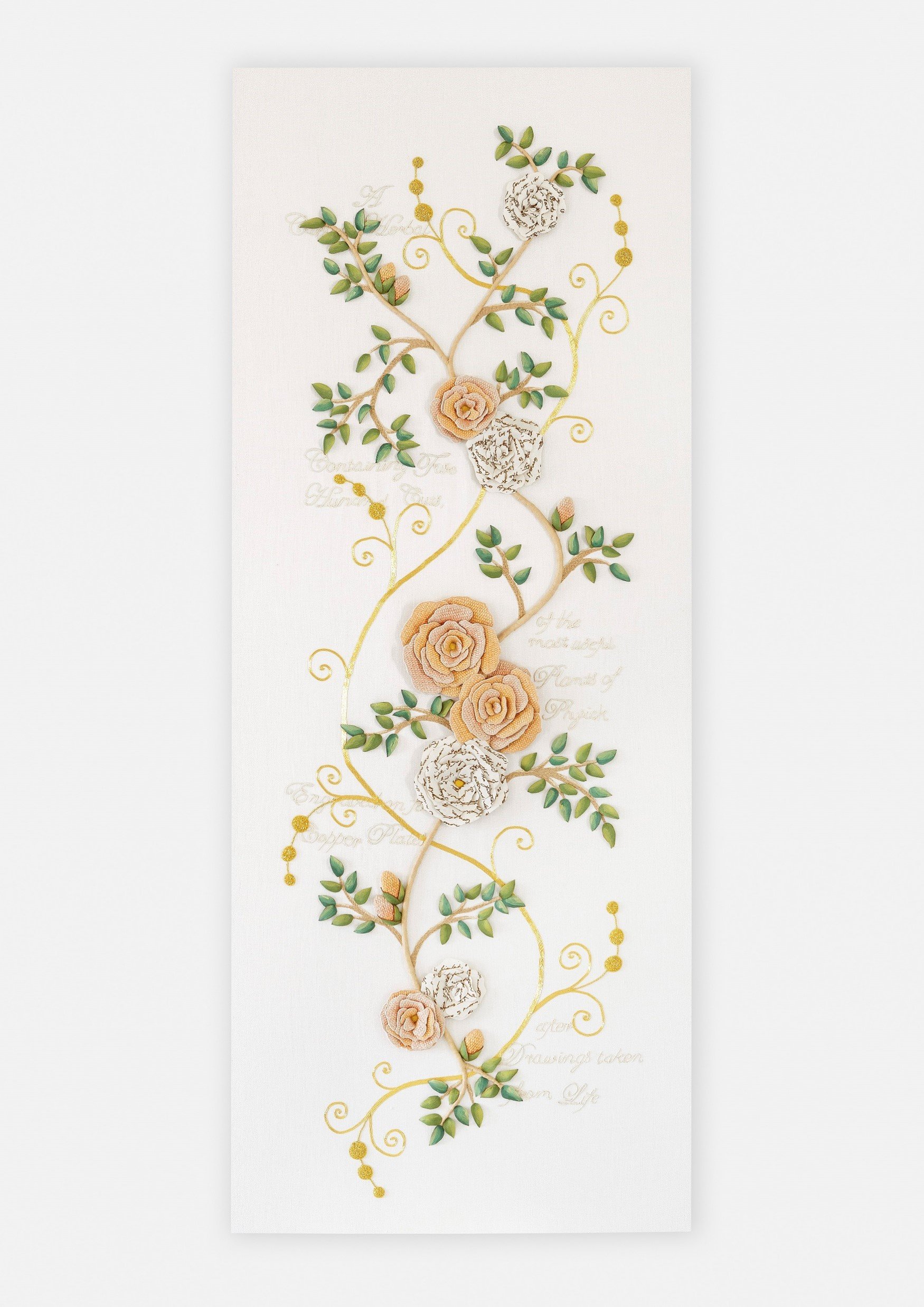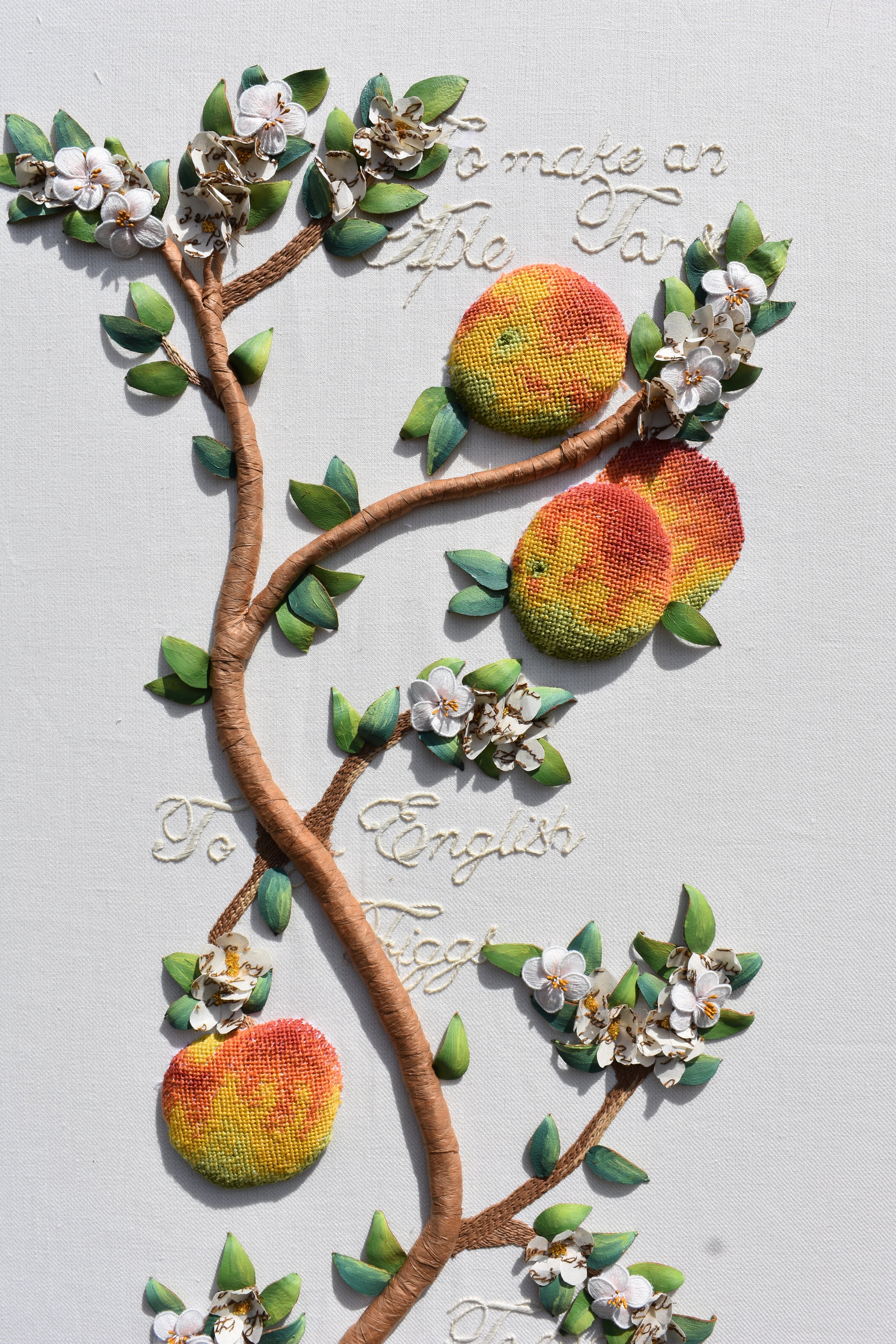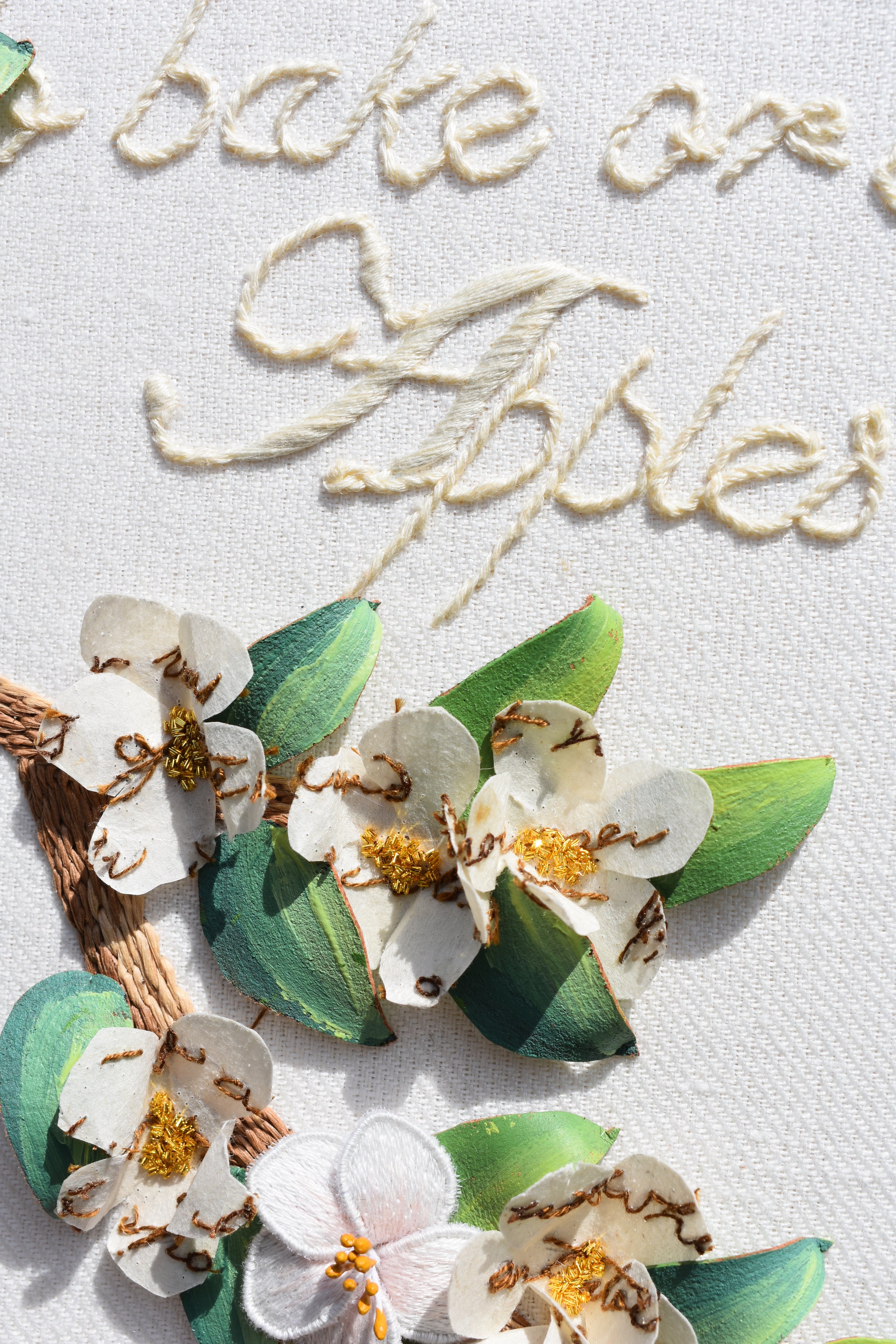“I have found Chawton House an endless source of inspiration ”
This month, Emily Barnett talks about the influence of Chawton House, childhood home of our Founder & Chair, and Jane Austen on her final embroidery project for her Master’s degree.
I am a textiles artist who specialises in hand embroidery, taking inspiration from the rich flora and fauna of the English countryside. My practice focuses on creating embroidered textiles for the luxury interiors sector, ranging from wall pieces to furnishing with an emphasis on high quality craftmanship.
I studied at The Royal School of Needlework (RSN) based at Hampton Court Palace, where I was taught traditional hand embroidery stitches and techniques including Goldwork, Raised work, Silk Shading, and Tambour. I graduated this summer with a 1st class degree in hand embroidery, and I have developed a passion for embroidery and design. Whilst studying at RSN, I had the opportunity to work for Alexander McQueen and luxury interiors company Fromental, who specialize in hand-embroidered and hand-painted wallpaper. One of the highlights of my university experience was being able to contribute to the RSN collective project of embroidering the Anointing Screen for the Coronation of King Charles III earlier this year.
King Charles III Anointing Screen designed by iconographer Aidan Hart and embroidered by staff and students from the Royal School of Needlework
Growing up in the English countryside and living relatively close to Chawton in Hampshire, my relationship with Chawton House began whilst I was studying for my A levels at Alton College, and I became an assistant in the tearoom, working in the holidays and at weekends. I loved being a part of the team in such a beautiful and historic location. COVID-19 was a major part of my university experience with lockdowns impacting the end of my first and much of my second year. Most of this time was spent studying remotely. During this time, I came back to work at Chawton House, which helped to give me a sense of stability/normality. I enjoyed being able to take on new responsibilities too, as a General Assistant, which gave me the chance to discover more about the House and its history. I am very grateful for the support I received from the Chawton House Team, who always encouraged me on my creative journey.
As an artist, I have found Chawton House an endless source of inspiration from its association with Jane Austen to being able to explore the grounds throughout the changing seasons-seeing the abundance of snowdrops in the Wilderness in early spring to the wide variety of roses in the Walled Garden in the summer and the heavily laden apple trees in the Orchard in the autumn. I am also very fortunate to have had access to the Library’s collection of historic and beautiful botanical illustration books, including Elizabeth Blackwell’s A Curious Herbal, which became a major source of inspiration for me.
Blackwell’s illustration of apples c. 1700-1758
The concept behind the Chawton House Project was to be able to recreate my experience of the House over the last 5 years, bringing together the beauty of the grounds with reference to its literary connections. The gardens truly are a photographer’s paradise, and I made the most of every available opportunity to explore, paint, and photograph these natural scenes.
The Chawton House Project consists of three embroidered wall panels - two side panels measuring 1.3 metres in height and a central panel that measures 1.5 metres in height. All three pieces have been created entirely from various hand embroidery techniques. I started embroidering these in mid-February 2023 and it took me until early September to complete the series, with a total of approximately 1,500 hours spent on the entire collection.
Each panel focuses on a different section of the garden, creating the botanical elements in an illustrative style through the use of raised embroidery techniques, silk shading (which creates realistic colour blending), and tonal canvas work. These have been used to capture the natural colours from my original watercolour and acrylic paintings. Hints of goldwork, embroidery with metal or imitation metal threads, emphasise the lustrous quality of these techniques adding a level of sophistication and luxury.
Bringing a contemporary twist to my work, I have also looked to current design trends within the interiors sector. These include the use of Biophilic Design, a trend that aims to improve wellbeing by bringing the natural world indoors – a trend that has grown in popularity since Covid-19 and the affect lockdown had on our mental and emotional health. Similarly, the Regency period was a time of uncertainty and change. For generations, country life was tied to the seasonal changes and agriculture. Seasonal festivals were important, bringing music, dancing, and large fairs into otherwise monotonous lives. However, the growth of the evangelical Christian movement clamped down on much of this indulgence in a move towards moral improvement. There was also a move towards a more informal lifestyle with a growing interest in the natural world. Towards the end of the 18th Century people felt they wanted to be in touch with nature, and this was reflected in their homes with the use of botanical wallpaper, vases of flowers throughout the house, and a rise in the popularity of having a conservatory, where houseplants could thrive throughout the year.
Jane Austen herself was inspired by the work of William Cowper, whose poetry extolled the virtues of unspoiled nature and by William Gilpin who, through his illustrated books, promoted picturesque tourism. The Napoleonic Wars had put a stop to the Grand Tour, and Gilpin urged his readers to explore the rugged landscapes of their native Britain instead.
“The Rose Garden”
For my project, I was able to use both botanical imagery and natural materials, using Linen for the backing material and Raffia for surface stitching and raised embroidery. I have also used reclaimed suede, which I hand painted with acrylic paint for the leaves.
Another key element of my project was to find a way in which I could incorporate references to Jane Austen due to her close association with the House. I have achieved this by bringing in hand-embroidered parchment paper petals that I scattered throughout the botanical elements of each piece to recreate text from Jane’s letters. I used a letter written by Jane to her sister Cassandra (24th January 1813), four day before the publication of Pride and Prejudice, from the Jane Austen’s House online Exhibition. The letter discusses Jane’s everyday life, including news of brother Henry’s gift of half a stilton cheese and of her mother knitting gloves to pass the time. Jane Austen also discusses volumes borrowed from the local Alton Book Society including Charles Pasley’s Essay on the Military Policy and Institutions of the British Empire (1810). I chose this particular letter as there was a reference to the people of Chawton within the script “& among so many readers or retainers of Books as we have in Chawton.” I felt that this seemed appropriate sentiment for my project and really helps to bring Jane Austen and her influence in Chawton to life.
The central panel “The Rose Garden” combines the Pride and Prejudice roses from the Rose Walk with a goldwork feature inspired by the ornate details of the garden gates. I wanted to pay homage to the beautiful botanical illustration books that had inspired me at the beginning of my project, so I used text from the title page of Elizabeth Blackwell’s A Curious Herbal (1737-1739), which I incorporated within the piece. As an amateur artist, I was able to turn to Blackwell’s beautiful illustrations to see how colour has been used to recreate texture and tone when recreating the botanical elements. I also found it helpful to see how different flowers have been used together and arranged within the page to create a composition. I have aimed to recreate Blackwell’s illustrative/ ‘painted look’ throughout my own work.
“The Rose Garden”
The second panel “The Library Terrace” focuses on celebrating the wide range of women writers that are in the House’s library collection. The composition blends a majestic wisteria plant with the names of notable women writers including Jane Austen, Aphra Behn, Frances Burney, Mary Wollstonecraft and Mary Shelley.
“The Library Terrace”
The final panel, “The Orchard”, was inspired by the beauty of the changing seasons at Chawton House, bringing together the heavy blossoms of springtime with the bountiful fruit from the heritage Cox apple trees in the autumn. I made the literary connection by incorporating the titles of recipes from the Knight Family Cookbook, including “To make an Aple-Tansey” and “To make Black-berry Wine” into my piece.
“The Orchard”
Over the summer, my work was exhibited at RSN as part of the annual Degree Show and also at New Designers in Islington, London where it was part of a much larger exhibition. During this time, I was approached by Sanderson Design Group and offered a three-month placement, working as a junior designer, which I am currently undertaking.
I am also delighted to have recently been shortlisted as a finalist for Hand And Lock The Prize, which is a prestigious and global competition. The Chawton House Project will be on display at the Omni Gallery in London from November 10th -12th 2023 and also at The Knitting and Stitching Show in Harrogate from 16th-19th November 2023.
My final goal is to return these precious embroideries to Chawton House as it was the catalyst for my project. I am currently discussing a potential exhibition with the team at Chawton House which will hopefully take place during the spring/summer 2024.
© Emily Barnett 2023. Emily Barnett is a recent RSN graduate and has a passion for the countryside and hand embroidery.
Join our Founder Caroline Jane Knight and Jane Austen Literacy Foundation Ambassador Alison Larkin, for their annual celebration of Jane Austen's birthday, live on Facebook on Sunday 17th December at 3pm EST, 8pm GMT and 7am Monday 18th in Australia.
While we enjoy a cup of tea and birthday cake, Caroline and Alison will reflect on a busy 2023 with the Foundation and other projects, and look forward to the coming year. Discussions will include Caroline and Alison’s visit to Chawton House, Caroline’s childhood home, the launch and popularity of The Jane Austen Podcast with Alison Larkin and the debut London debut of Grief…A Comedy, written and performed by Alison. Caroline's will share her plans for exhibiting her extensive collection of vintage fashion (1775 - 1880) curated as Jane and her characters, and for a follow up to her memoir Jane & Me; My Austen Heritage.
Join us for an hour of fun and lively discussion (including a prize giveaway), with two friends that share a passion for literacy and laughter.
The event will be broadcast live on the Jane Austen Literacy Foundation Facebook page and is free:
Kick off the holiday season with a special community event! Join the Jane Austen Literacy Foundation Community as a Patreon Member on Zoom December 2nd at 3 PM EST, 8 PM GMT, and 8 AM Sunday December 3rd in Australia for a delightful afternoon with International bestselling author Natalie Jenner, also a Foundation Ambassador. 📚
Engage in a Q&A session, and then cozy up for a Little Women watch party. 🍿❤️ Don't miss the festive fun! 🎄📖
(Please note - due to copyright laws the watch party will be in Zoom chat with no camera access. You will need to have Little Women playing on your own device. We will all be pushing play at the same time. Stay tuned for more details!)
Jane Austen Literacy Foundation Community
Join us free on Friday evenings at 8pm EST (Saturday 12 noon in Australia) for our community Read With Us.
This is a special time where we cozy up, read a book of your choosing and enjoy some quiet time together.
You can find out more about the Jane Austen Literacy Foundation Community here:
